If you want to know about the evolution of Hindu temple architecture or river valley civilizations or evolution of Vedic civilization, please click the link.
Jain temple architecture is a style of temple architecture that developed as a part of Jainism, an ancient Indian religion that emphasizes non-violence and respect for all living things. Jain temples are typically characterized by their simple, yet elegant design and their emphasis on symmetry and proportion.
- Founder of Jainism is Mahavira, last Tirthankara/Saints.
- All Jain Temple are dedicated to 24 Tirthankara.
- In Jain temple, bricks are hardly used.
- Carving out temples from rock faces was adopted Jain had the concept of mountains of immortality (to live forever). So, they built temple in hills.
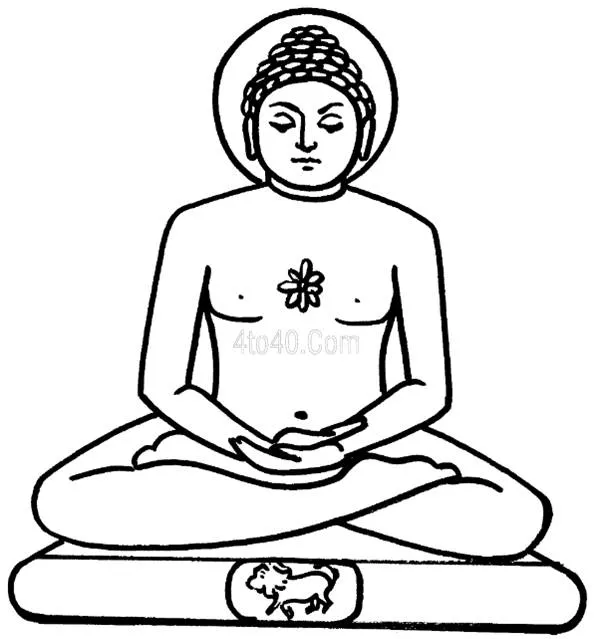
- Jain temples are built with various architectural designs.
- Jain temples in North India are completely different from the Jain temples in South India, which in turn are quite different from Jain temples in West India.
There are two type of Jain temples:
- Shikar-bandhi jain temple (one with the dome)
- Ghar jain temple (Home Temple without dome)
There are indeed two main types of Jain temples: Shikar-bandhi temples and Ghar (home) temples.
Shikar-bandhi temples are the more traditional, larger Jain temples that feature a dome-like structure (shikhar) on top. These temples often have multiple levels and large, elaborate entrance halls (mandapas) with intricate carvings and sculptures. The central shrine in a Shikar-bandhi temple typically houses an image of a Tirthankara, and the temple serves as a gathering place for Jain devotees.
Ghar temples, on the other hand, are smaller, more intimate temples that are meant to be used as personal shrines within a household. These temples do not have a dome and are typically less ornate than Shikar-bandhi temples. Despite their smaller size, Ghar temples are still considered to be important centers of worship for Jain devotees, and are used for daily prayers and rituals.
Both types of Jain temples reflect the Jain values of non-violence and reverence for all forms of life, and both serve as important centers of worship and learning for Jain communities.
Shikar-bandhi jain temples
- They have many marble pillars which are carved beautifully with Demi god posture.
- There is always a main deity also known as mulnayak in each derasar.
- The main part of Jain temple is called “Gambhara” (Garbha Graha) in which there is the stone carved God idol.
- A Jain temple which is 100 years old is called a TIRTHA.
- The main deity of a Jain temple is known as a Mula Nayak.
- A Manastambha (column of honor) is a pillar that is often constructed in front of Jain temples.
1) Elements of jain architecture
The elements of Jain architecture are characterized by their simplicity, elegance, and emphasis on symmetry and proportion. Some of the key elements of Jain temple architecture include:
- Jain temples have numerous pillars having a well-designed structure, forming SQUARES.
- The squares thus formed create CHAMBERS, used as small chapels and contains the image of a deity.
- From these pillars, there are richly carved brackets that emerge at about two thirds of their height.


- The roofs have pointy domes and wherever there is a dome, the pillars are omitted to create an octagonal space within.
- The only variation in architecture specific to Jain temples is the frequently seen four-faced or Chaumukh design.
- In these four faced temples, the image of a Tirthankar faces back to back to face four cardinal directions.
- Entry into these temples is also from four doors that face the cardinal directions.

- Mandapa: The entrance hall of a Jain temple is known as a mandapa. This large, open space is typically pillared and serves as a gathering place for worshipers.
- Garbhagriha: The central shrine of a Jain temple is known as the garbhagriha. This small room houses an image of a Jain deity, typically carved from marble or installed as a metal statue. The garbhagriha is considered to be the most sacred part of the temple.
- Mukhamandapa: The mukhamandapa is a pillared hall located in front of the garbhagriha. This space is used for prayers and rituals and is often adorned with intricate carvings and sculptures.
- Shikhar: The shikhar is the dome-like structure that sits atop a Shikar-bandhi temple. This distinctive feature of Jain temple architecture is meant to symbolize the spiritual aspirations of Jain devotees.
- Devakoshta: The devakoshta is a small shrine located near the garbhagriha. These shrines are dedicated to each of the 24 Jain Tirthankaras and are often adorned with intricate carvings and sculptures.
- Vedi: The vedi is the altar in front of the garbhagriha where offerings are made to the deity.
- Torana: The torana is an ornate gateway or archway that serves as the entrance to the temple. These structures are often adorned with intricate carvings and sculptures and are meant to symbolize the transition from the material world to the spiritual world.
These are some of the key elements of Jain temple architecture. Each element is designed to create a peaceful and harmonious atmosphere for meditation and worship, and reflects the Jain values of non-violence and reverence for all forms of life.
3) Chaumukh design
The Chaumukh design is a four-faced design that is commonly used in Jain temple architecture. This design features four faces, each facing one of the cardinal directions, and is used to depict the Tirthankara in a standing or meditative posture. The Chaumukh design is considered to be one of the most sacred symbols in Jainism, as it represents the Tirthankara in his or her fully enlightened state.
The Chaumukh design is typically carved into a large stone image of the Tirthankara and may be displayed in the main shrine room of the temple. The four faces are often accompanied by intricate carvings and sculptures that depict scenes from Jain mythology, as well as symbols and motifs that are meaningful in Jainism.
The Chaumukh design serves as an important focus of worship for Jain devotees and is considered to be a powerful symbol of the Tirthankara’s teachings and guidance. The use of the Chaumukh design in Jain temple architecture is seen as a way of preserving and promoting the core principles of Jainism, and of providing a place for devotees to connect with the Tirthankara in a meaningful and spiritual way.
- The central shrines of these temples are opened to four directions, and in front of each side, there is a “mandapa” (hall) covered by a domical ceiling.
- It is called “Chaumukh” or “Chaturmukha” (four faced) image.
- If a temple is dedicated to this chaturmukha image, its garbhagriha is also opened to all four directions, thus provides mandapa, which represent a place of both worship and teaching, in front of each side.
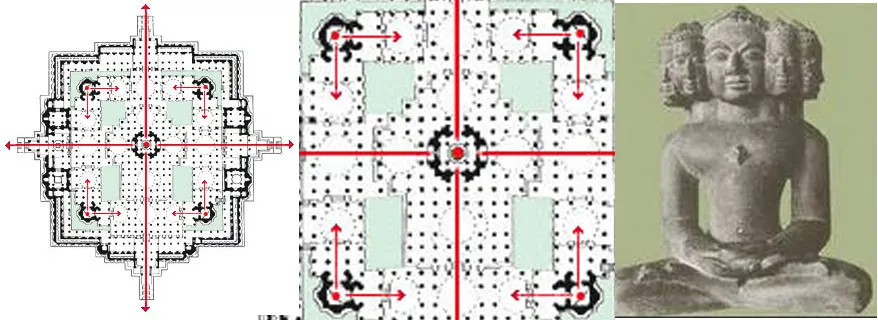
i) The Ideal Plan of Jain Temple
- All shrines have “Shikhara” (tower on the sanctum) and flagpole, mandapas are covered by domes or “Samvarana roofs.”
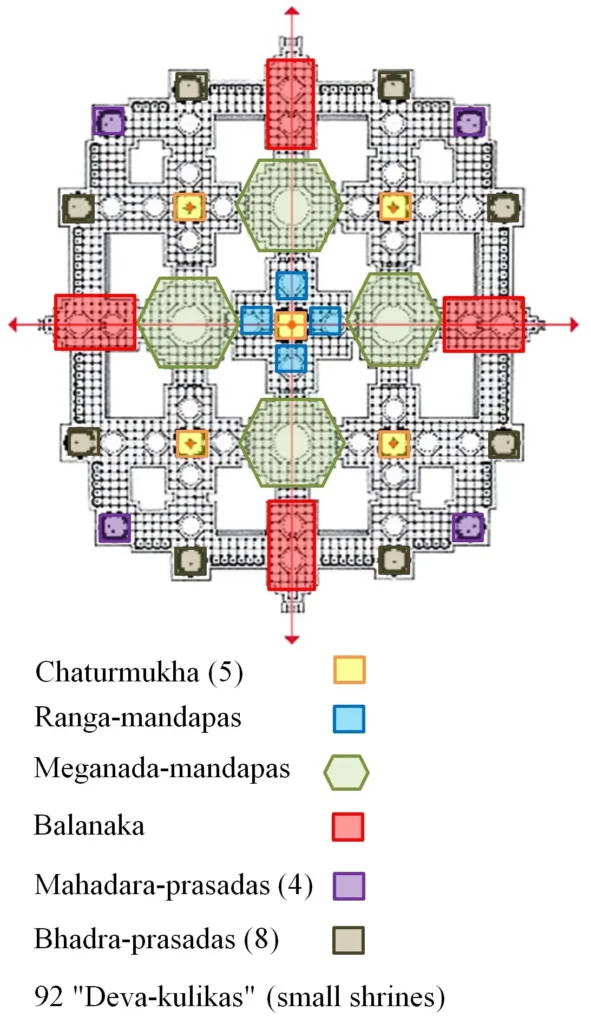
The ideal plan of a Jain temple can vary depending on regional and historical factors, but there are several key elements that are commonly found in the architecture of Jain temples. The ideal plan of a Jain temple typically includes the following elements:
- Entrance: The entrance of the temple is typically a large and elaborately decorated portal that serves as the gateway to the temple complex. This entrance is often adorned with carvings, sculptures, and inscriptions that depict religious themes and symbols.
- Mandapa: The mandapa is a covered porch or entrance hall that leads into the main shrine room. This space is often used for congregation and community gatherings, and may be decorated with intricate carvings and sculptures.
- Main Shrine Room: The main shrine room is the most important space in the temple, and is typically dedicated to the Tirthankara. This room may contain a large image or statue of the Tirthankara, as well as smaller shrines dedicated to other Tirthankaras.
- Antechamber: The antechamber is a smaller room that is located just before the main shrine room. This space may be used for private worship or meditation, and may contain smaller shrines dedicated to the Tirthankaras.
- Sabha Mandap: The sabha mandap is a hall in a Jain temple where religious meetings, lectures, and other events are held. This space is often used to promote education and learning within the Jain community.
- Dharamshala: A dharamshala is a rest house for pilgrims and visitors to the temple. These structures are often attached to the temple and provide accommodations for travelers.
These elements form the basic layout of the ideal Jain temple, and provide a complete environment for worship, learning, and community gatherings. The precise arrangement and design of these elements can vary greatly from temple to temple, but the core principles of Jain temple architecture remain consistent across all Jain communities.
4) Ranakpur chaturmukha jain temple

- This temple has four Mahadhar Prasads (Principal Shrines) in four directions with artistic entrances. 72 inches tall four white marble image of Bhagvan Adinath is installed here.
- The upper floors also have identical images in four directions.
- The orientation of the temple in four direction and installation of four idols have given it popular name to this temple as Chaturmukha Jain temple.
- This temple has many artistic pillars each one with different design and with beautiful carving in it. These pillars are arranged in such a way that they never obstruct the view and from any corner devotees can have darshan.
- There is a popular belief that there are about 1444 pillars in the temple.
Plan of temple

- Central Main Shrine is called “Mula-prasada,” its interior is Garbagriha” (sanctum).
- A – Assembly Hall in front of four portals of the main shrine. Each Ranga-mandapa connects with three storyed “Meghanada- mandapa”.
- B – High Hall in front. Having four “Mahadara-prasada” (two-faced-shrine) diagonally in four directions of the main shrine, the temple type is “Panchayatana” (five-shrined- type).
- In addition to this, there are two “Bhadra- prasada” east and west sides, making the total composition much more intricate
- A line of “Deva-kulika” (small shrine) along “Bhamati” (cloister) surround the whole complex.
- All these shrines hold a statue of Tirthankara or Jina (four in Chaturmukha, two in Mahadara- prasada), there are more than 100 statues in total.

5) Dilwara temple, mount abu
- Located about 2½ kilometres from Mount Abu, Rajasthan’s only hill station.
- Built by Chalukya during 11th to 13th century A.D
- One of the finest Jain Temple
- Known world over for its extraordinary architecture and marvelous use of marble stone carvings.
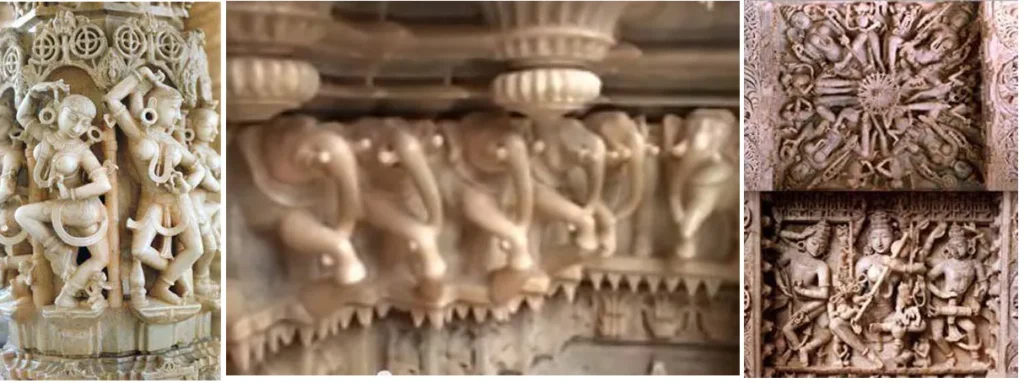
Dilwara Temple complex has been devoted to 4 Jain Tirthankars:-
- a) Vimal Vasahi, dedicated to first Jain Tirthankara, Adinath
- b) Luna Vasahi, dedicated to 22nd Jain Tirthankara, Neminatha
- c) Pittalhar, dedicated to first Jain Tirthankar, Rishabha
- d) Parshvanath, dedicated to 23rd Jain Tirthankara, Parshva
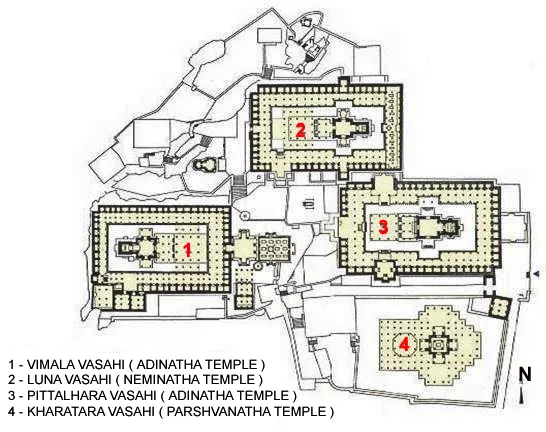
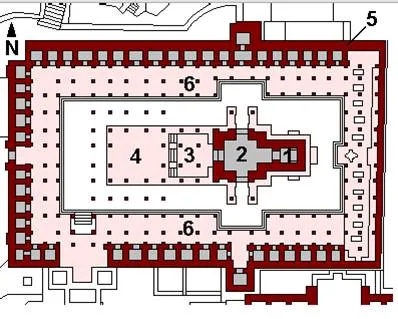
- = Garbha Griha (Sacred Place for Tirthankara)
- = Gudhamandapa (Small Prayer Hall)
- = Navchoki ( Assembly Hall )
- = Ranga Mandapa (Ceremonies Hall)
- = Enclosed Walls/Chapels
- = Semi Covered Areas
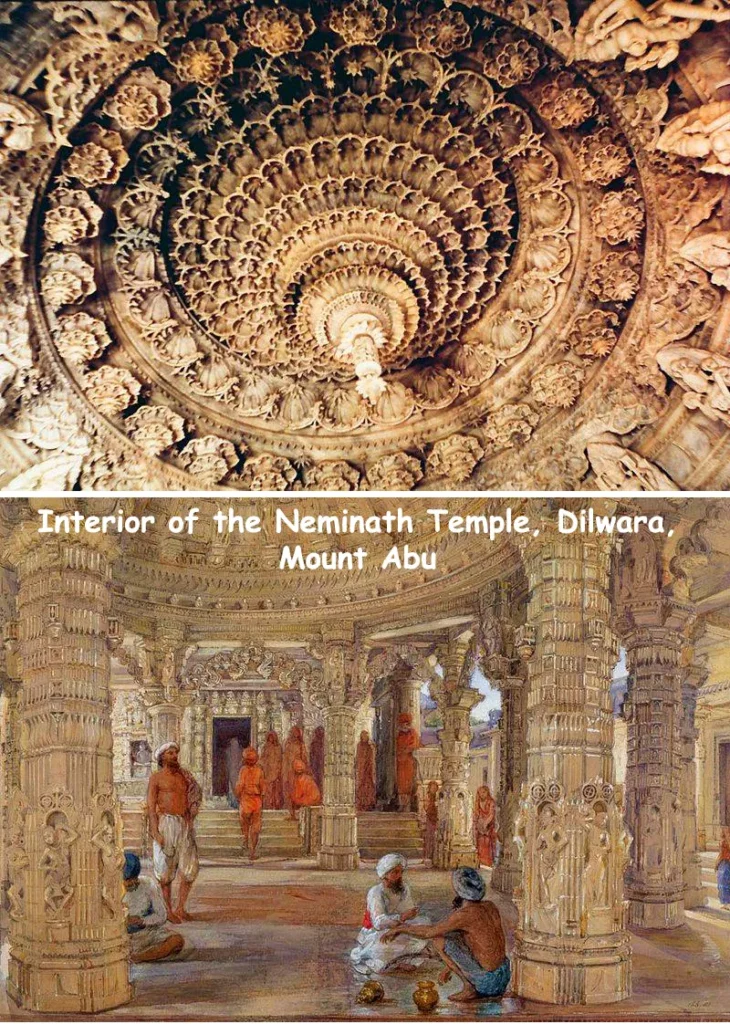
6) Other famous Jain Temple
- Nasiyan Temple Ajmer
- Hatheesing Jain Temple, Ahmadabad
- Digambar Jain Temple, Delhi
- Vimal Vasahi Temple
- Pittalhar Temple
- Shri Parshwanath Temple
7) Hindu temple Vs Jain temple
Hindu temple
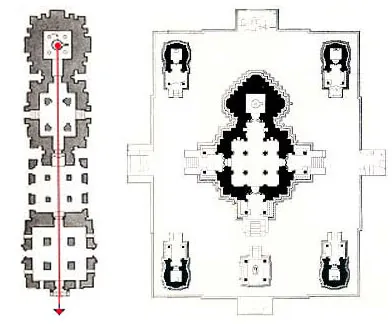
- The basic form of hindu temple is “garbhagriha+ mandapa”.
- The garbhagriha at Hindu Temple is the House Of Gods.

Jain temple
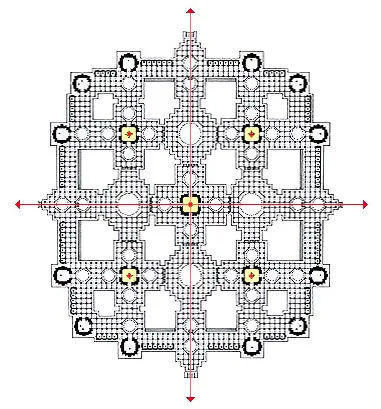
- The basic form of jain temple is four faced – Chaturmukh Design (Gambhara– Garbhagriha).
- Jain temple means the “place where doctrine of Jina should be preached in all directions.” and accordingly, “Tirthankara” (Jina) should be locked teachings.
- It is called securely as a human “Samavasarana,” and the residence.
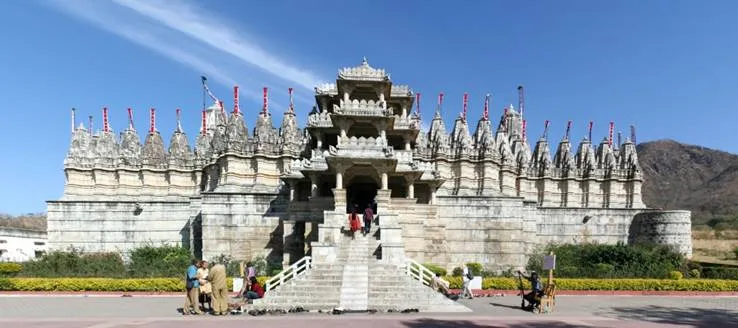
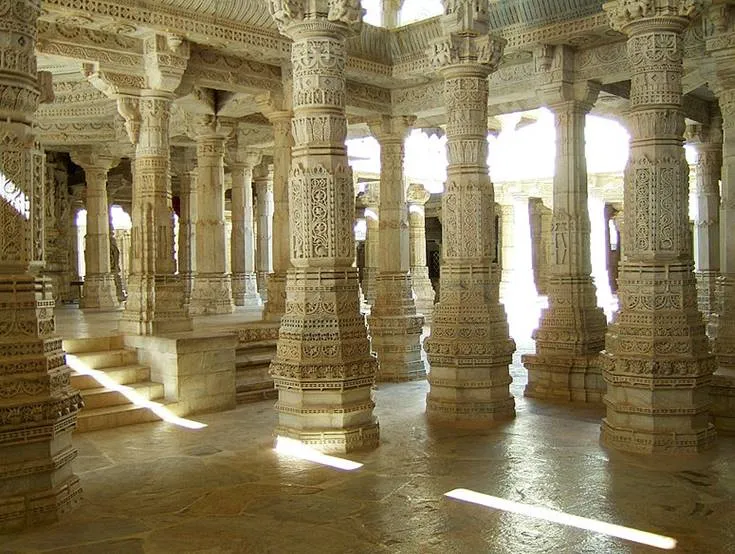
8) Overview
- These temple-cities were not built on a specific plan; instead they were the results of sporadic construction.
- Natural levels of the hill on which the city was being built accommodated various levels so that as one goes higher so does the architecture and grandeur increases.
- Each temple, though, followed a set pattern, styles, designed on principles of architecture in use during the period.
- Compared to the number of Hindu temples in India, Jain ones are few and spaced out.
- Jain temples are said to be the richest temples in the world, surpassing even Mughal buildings in terms of grandeur and material wealth.
Overall, Jain temple architecture is known for its beauty, symbolism, and attention to detail, and it is an important part of Jain culture and heritage.
The information can’t be copied.